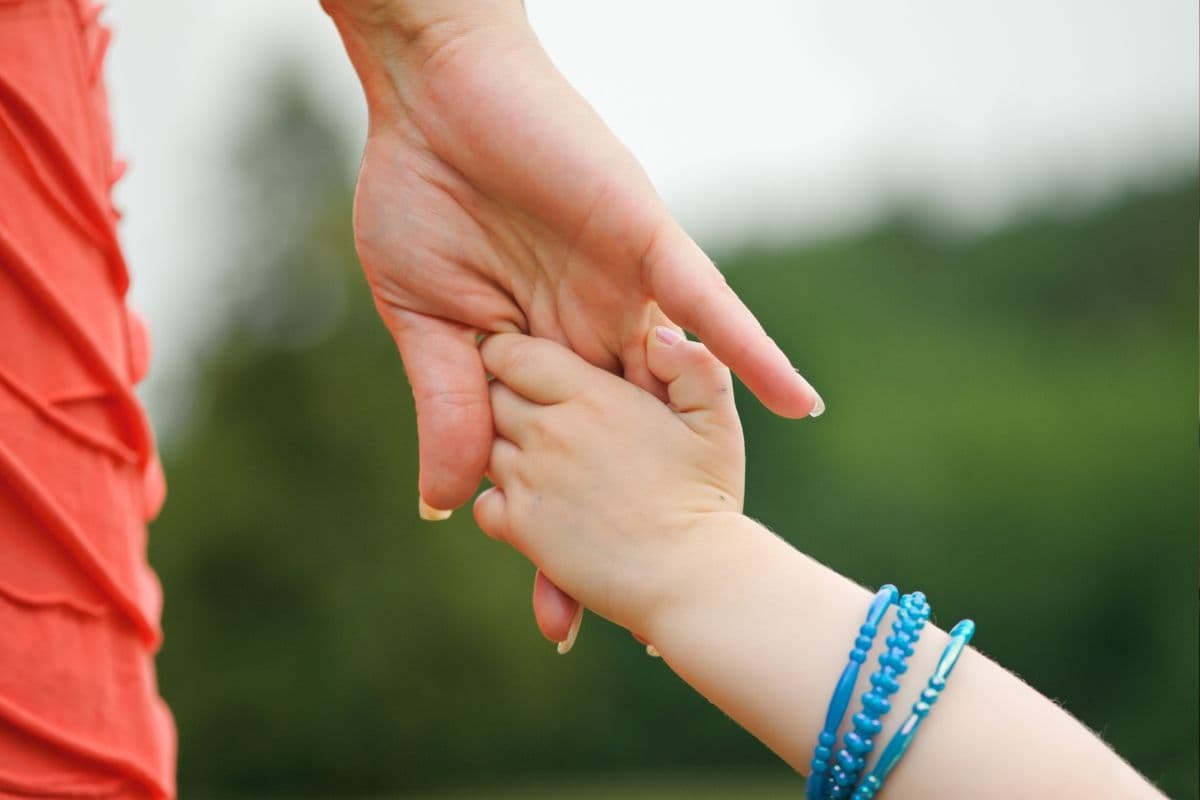
Attachment Theory: Attachment TEST and how to work with it

You’ve probably heard that our childhood has a huge impact on our later relationships. You may have come across the term “daddy/mommy issues” on social media, or a friend may have told you that she’s having trouble finding a healthy relationship because of childhood trauma. But does it really have that much of an impact? Childhood was so long ago!
According to the theory of attachment, this is indeed true. In this article, we’ll not only introduce it to you, but we’ll also help you discover yours using the attachment test.
Thanks to this, you’ll understand yourself better and find out how you can improve your relationships – to make them calmer and healthier. Our psychotherapists have lots of useful advice for you.
What is attachment theory and how can it help you?
The authors of attachment theory are psychoanalyst John Bowlby and psychologist Mary Ainsworth. This theory examines how our first relationships (with parents or caregivers) influence how we function in later relationships.
Each of us takes away different experiences from our childhood. When we are little, we are just discovering the world – we are incredibly perceptive and vulnerable. How did your parents behave in difficult times? Did they listen to you or did they beat you up? Did they hug you or ignore you? All of this can affect how you will handle closeness, trust and conflicts in relationships with partners and friends.
Remembering how your childhood actually went can be painful. Maybe you didn’t even think about it that much or you preferred to push it out of your memory. But understanding your childhood can help you enormously towards healthier relationships – when you find out why something happens, it is a lot easier to work with it.

Types of emotional attachment: Secure, anxious, avoidant, and disorganized
There are four types of attachment. They depend on how your parents met (or didn’t meet) your needs as a child.
What needs are we talking about? These include love, security, attention, physical contact, but also enough independence and space to explore the world. Then there’s emotional availability from your parents, space to express your emotions, and even enough food and basic needs – like breastfeeding, sleep, hygiene, or warmth.
Let’s take a look at all four types of attachment.
1. Secure emotional attachment
A secure attachment develops in children who have felt enough love and whose parents have met their needs. Or in people who have worked a lot on themselves throughout their lives and have broken free from the influence of their parents.
People with this type of emotional attachment trust their partner, have healthy self-esteem and can communicate openly. They have no problem showing affection and accepting rejection. They often feel good even without a partner. They try to resolve conflicts or jealousy through dialogue.
2. Anxious emotional attachment
Do you crave closeness but are constantly afraid of losing it? Do you often demand confirmation of your love from your partner? Do you suffer when you are without a partner? Do you feel a strong fear of rejection and do not trust yourself? Then it is possible that you are prone to an anxious type of emotional attachment – these people have trouble trusting others and often have the need to control their partner and cling to them tightly.
This is because their parents met their needs unpredictably. Sometimes they were warm, other times they were unavailable. The child did not know when they would receive love and security again.

3. Avoidant emotional attachment
People with avoidant attachment styles value independence. They often have difficulty with trust and closeness. When they feel threatened, they close down. When their partner tries to get to know them better or see them more often, they may feel suffocated in the relationship and lack personal space. They usually don’t want to admit that they need someone because dependency is seen as weakness.
Why does this happen? The parents of these people did not meet their emotional needs during their childhood. They could be physically present and provide for basic needs, but there was a lack of emotional connection. For example, they demanded independence and quiet from the child. They rejected their strong emotions instead of helping them to manage them.
The result? The child has learned to suppress their emotions, not to be in contact with them, and to rely mainly on themselves. They may associate closeness with the risk of rejection or lack of acceptance, and therefore prefer to avoid it in adulthood.
4. Disorganized (anxious-avoidant) relationship attachment
The last type of emotional attachment combines avoidant and anxious attachment – it appears in people who experienced gross neglect or abuse in childhood. For them, their parents were a source of both safety and fear.
For example, a mother first beats her child badly because his behavior affects her traumatized part of her personality. And she can’t control herself. But then she apologizes to him, kisses him, and this cycle goes on and on. The child is thus unable to create a stable way to establish a relationship.
If something similar has happened to you, you probably often struggle between love and panic in relationships – this can lead to outbursts of jealousy that are rooted in deep pain. You have chaos inside because you long for love, but at the same time you are afraid of it. You are afraid of rejection and loneliness, and at the same time of intimacy and closeness.
Attachment style test: Find out what type of attachment you have
Are you curious about how you approach your relationships? Come and find out in our short test. It only takes a few minutes and will help you understand how you function in relationships.
Don't worry. Your emotional attachment is not a sentence for life. It can be worked on. It also happens that we have a different attachment in friendship and another in partnership. Or some attachment only manifests itself in situations when we are under pressure. Come and find out the results.
How to work with your attachment type to help you have happier relationships
Every emotional bond was created as a survival plan in the conditions set by your parents. It doesn't make you bad. But it may be draining you more than protecting you. Or it may be getting you into chaotic, stressful relationships.
But childhood doesn't have to affect you forever. We have practical advice from our psychotherapists to help you understand your bond and start creating relationships that make you feel good, step by step.
How to work with a secure emotional attachment?
If you tested as having a secure attachment, you probably have a healthy relationship with yourself and others – you are able to trust, open up, but also accept rejection and be happy with yourself. What can you work on in the future?
- Trust your intuition when something is making you feel uncertain. Your “relationship compass” is probably working – don’t be afraid to listen to it when you feel something is bothering you in your relationship.
- Stay open to working on yourself. Even people with secure attachments can get caught up in the dynamics of an anxious or avoidant partner. Pay attention to your emotions and trust your own judgment. This will help you avoid more challenging moments in time.
- Be supportive, but not at the expense of yourself. If you're in a relationship with someone who has a more vulnerable type of emotional attachment, it's great that you want to help them and be there for them. Just remember to be careful not to lose yourself in the process. Can you set clear boundaries and say "no" when necessary?
It's never too late (or too early) to start practicing self-confidence and self-love. Even if you think you have enough of them. And if you're in a relationship with an anxious person, our article on jealousy can help you - we'll give you advice on how to work with jealousy in your partner.

How to work with anxious emotional attachment?
Anxious emotional attachment often leads to jealousy. Do you find it difficult to trust others? Do you often feel afraid that they will leave you? Life has probably taught you that security is not something you take for granted. But it is something you can work on.
- Try practicing how to manage jealousy. Our article How to get rid of jealousy in a relationship will help you. We'll show you what small steps you can try every day to stop being limited by the fear of losing your loved one.
- Work on your self-confidence and self-love. You definitely deserve love – right now. Learn to believe in yourself and not try to please or please others at all costs. Read therapists' advice on how to increase your self-confidence and how to truly love yourself.
A healthy relationship should make you feel safe. If you've been through so much that you don't even know what a relationship is like, read these 5 rules for a healthy relationship. Love, security, and trust aren't something you have to earn. Being in a relationship with someone who returns them can help you move toward a more secure emotional connection.
How to work with avoidant emotional attachment?
Do you value your independence and carefully monitor who you spend your precious time with? But maybe deep down, it doesn’t fulfill you as much as you would like?
Your independence may be hiding a fear of intimacy – perhaps you learned as a child that no one cares about your emotions, so you started hiding them. As an adult, it can be difficult to let someone close to you. You don’t want to put yourself at risk. What can you try?
- Learn to recognize your emotions. When was the last time you felt sadness, joy, anger? Notice your bodily reactions and try to name your emotions or write them down on paper. As soon as you notice them, allow yourself to experience them. First, calmly in private, if opening up in front of another person seems like a horror to you. Feeling emotions is not a weakness, it is a natural human reaction – and any suppression of them will burst sooner or later.
- Practice openness in small steps. You don’t have to say everything at once. Just start with sentences like, “This is hard for me to talk about, I can’t put a name to it. Can you give me some time?” Later, you can confide in something else and continue at your own pace.
- Notice when you “disconnect.” For example, when your partner starts talking about the relationship or when you feel overwhelmed – instead of running away, consider taking a short break. Take a breath, try to explore your feelings and find out what is really bothering you. When you name the cause, it often subsides. Returning and communicating are then a lot easier.

How to work with disorganized emotional attachment?
Disorganized attachment can be incredibly challenging. It combines anxious and avoidant attachment. The desire for love, pain, and fear combine into one chaotic cocktail.
If you feel like this might be your case, don’t be afraid to ask for help. Therapy is extremely effective in this case – it will help you leave the difficult period behind and stop allowing your past to influence your current relationships.
If you don’t feel like going to therapy yet, try our recommendations for anxious and avoidant attachment above. Try to recognize situations when you act anxiously and when you act avoidantly, and try to work with them.
Jealousy is typical for your type of attachment. If it bothers you, explore methods for working with jealousy. They will help you silence the alarm in your head that tries to convince you that you are in danger.
Come discuss your emotional attachment in therapy
Relationships should make you happy, not make you suffer and burden you. It's okay to ask for help - together with a therapist you will explore where your fears come from and slowly dissolve them. You deserve a relationship that makes you feel really good.
At Hedepy, among many verified psychotherapists, you are sure to find the right one. To make it easier for you, we will recommend the most suitable therapist for you based on a 5-minute test. You can have your first session in just a few days.
Thinking about therapy?

My First Therapy: How to Prepare and What to Expect

What is psychotherapy? And who is it for?


